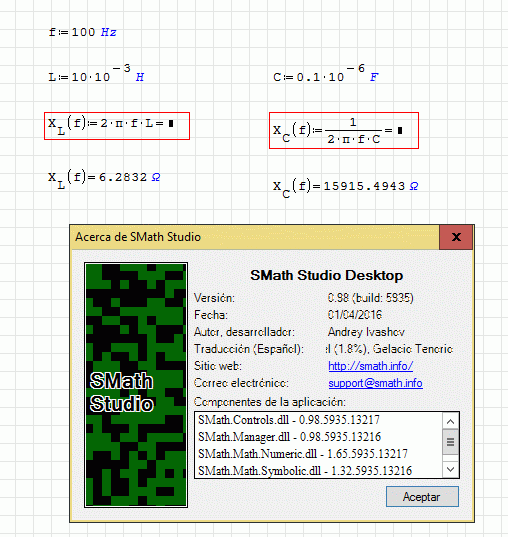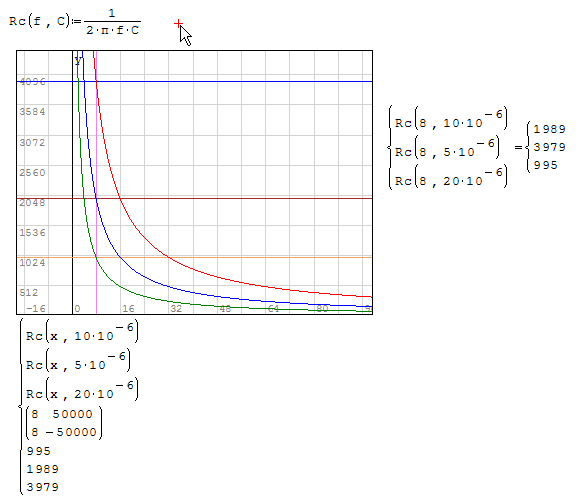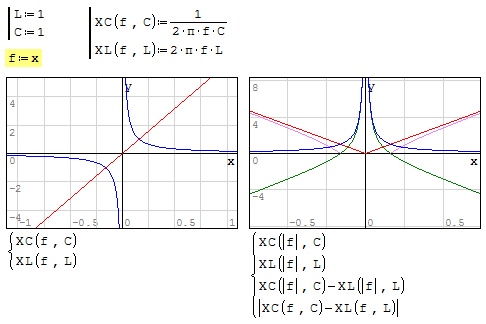Operation with units: f is not defined - Сообщения
Hi Basile.
That's is the expected way to work with smath.
To get the value of X.C you must to call the function after defining X.C with X.C(f)=
Best regards.
Alvaro.
That's is the expected way to work with smath.
To get the value of X.C you must to call the function after defining X.C with X.C(f)=
Best regards.
Alvaro.
Alvaro,
Look to the left the of X.C , the X.L
Should behave the same?
Basile
Look to the left the of X.C , the X.L
Should behave the same?
Basile
Same problem as before: you have no circuit, then no LC project.
The only thing you can do is calculate the resonance frequency: 'fo'
Then plot it as sin(fo)
The only thing you can do is calculate the resonance frequency: 'fo'
Then plot it as sin(fo)
Jean,
I am calculating the reactance of the inductor and the capacitor at a frequency f.
Basile
I am calculating the reactance of the inductor and the capacitor at a frequency f.
Basile
In my times, pure L, C were strictly imaginary. Just by themselves they don't have much use
whereas there is no such thing as pure L , pure C. They both have physical resistiviy.
whereas there is no such thing as pure L , pure C. They both have physical resistiviy.
Jean,
You are right that:
X.L=jωL
and
X.C=-j(1/ωC)
and the magnitude is that I calculate.
You can simply consider ideal elements without the loss resistance.
Basile
You are right that:
X.L=jωL
and
X.C=-j(1/ωC)
and the magnitude is that I calculate.
You can simply consider ideal elements without the loss resistance.
Basile
Hi Basile. That's isn't.
Correct XL and XC (reactances) are without j, as in your worksheets.
ZL and ZC (impedances) are with j.
Actually the total impedance is Z = R + jX, where X = XL + XC is the total reactance.
Best regards.
Alvaro.
Correct XL and XC (reactances) are without j, as in your worksheets.
ZL and ZC (impedances) are with j.
Actually the total impedance is Z = R + jX, where X = XL + XC is the total reactance.
Best regards.
Alvaro.
Alvaro,
You are confusing things.
What you say are correct but have to do nothing to do with the question.
X.L, X.C are reactance (with j or without j)
Z is impedance of R and X.
Basile
You are confusing things.
What you say are correct but have to do nothing to do with the question.
X.L, X.C are reactance (with j or without j)
Z is impedance of R and X.
Basile
WroteAlvaro,
You are confusing things.
What you say are correct but have to do nothing to do with the question.
X.L, X.C are reactance (with j or without j)
Z is impedance of R and X.
Basile
Hi Basile. I don't confusing. Reactances ( https://en.wikipedia.org/wiki/Electrical_reactance ) are reals and impedances ( https://en.wikipedia.org/wiki/Electrical_impedance ) are complexes. So X.L, X.C can't have j.
About the numerical evaluation for a function, check this old post: http://en.smath.info/forum/yaf_postst640_Function-as-a-program.aspx
In X.L, X.C definitions as functions, f must to be a local variable. X.L(f) -> (symb evaluation) must to set the answer with "f", not with "100 Hz". And the numerical evaluation X.L(f) = must to be in red, as f as local variable isn't defined.
As a choice of the program writer, and what you can see in the last post of the above referenced, you can set all the local variables as globals with f(x) = 1*(line ... ). Actually I'm not comfortable with that behavoir, but is the choice of Andrei.
Best regards.
Alvaro.
Note that I have removed the unit system because
"Units don't match" error mesage ... so: zap !
"Units don't match" error mesage ... so: zap !
Jean,
"why units do not match? Are they both Ω?"
Basile
PS: Thank you for the discussion.
"why units do not match? Are they both Ω?"
Basile
PS: Thank you for the discussion.
Redefining subtraction or function.

Best Regards
Carlos
test resonance_CBG.sm (10,1 КиБ) скачан 613 раз(а).

Best Regards
Carlos
test resonance_CBG.sm (10,1 КиБ) скачан 613 раз(а).
- Новые сообщения
- Нет новых сообщений



